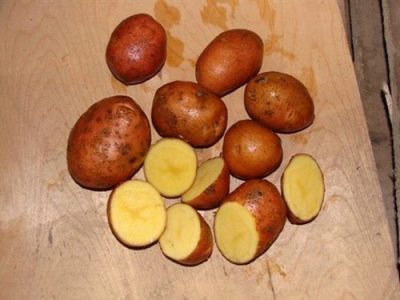
- Authors: EUROPLANT PFLANZENZUCHT GMBH, Germany
- Appointment: dining room
- Tuber weight, g: 59-115
- Peel color: red
- Color of the pulp: yellow
- Starch content,%: 12,2-17,3%
- Tuber shape: oval-round
- Peel structure: smooth
- Eyes: superficial
- The soil: undemanding
Many gardeners and farmers, choosing potatoes for planting, stop at early varieties that do not require special care and quickly adapt to the climatic conditions of the growing zone. The list of these includes the Rosalind variety of German selection.
Breeding history
Rosalind potatoes appeared thanks to the work of German scientists of the agricultural holding Europlant Pflanzenzucht GMBH more than 20 years ago. Despite the fact that the variety is currently excluded from the State Register of Breeding Achievements of the Russian Federation, it is in great demand among gardeners and farmers. The nightshade culture is zoned in the East Siberian, Central, North Caucasian and Central Black Earth regions.
Description of the variety
German potatoes are medium-sized bushes of an intermediate type, growing in height up to 50-60 cm.The compact bush with a semi-erect central stem is characterized by moderate thickening of bright green foliage, medium spreading branches and a developed rhizome, due to which about 16 tubers are formed in one nest.
The flowering of the bushes is short. During this period, small purple-red flowers appear on the bushes, which crumble very quickly.
Characteristics of the appearance of the bush and root crops
Rosalind represents a class of medium-fruited varieties. On average, tubers grow to a weight of 59-115 grams. The shape of the root crops is neat - oval-rounded with a smooth surface, rarely covered with small eyes, superficially planted. The color of the potato is uniform - pale red, sometimes with a yellowish tinge. The peel of the vegetable is quite dense, covered with a slight gloss.
Thanks to the strong skin, the dug potatoes are transportable, and also have a long shelf life (subject to light and temperature conditions). It is not recommended to store potatoes in a damp place, as this can provoke their rapid germination.
Purpose and taste of tubers
Rosalind table potatoes are famous for their pleasant taste, which captivates many housewives. The pale yellow pulp has an oily and dense structure without wateriness and mealy. It contains up to 17.3% starch. When peeled and heat treated, the potatoes do not change color, are slightly boiled, acquiring a delicate aftertaste.
The tubers are ideal for frying, baking, stewing, stuffing, adding to salads and soups, and for freezing in vegetable mixes.
Maturation
The variety is early maturing. The growing season lasts only 80-90 days. Germination of sprouts and maturation of root crops are amicable. The first digging can be carried out after 52-65 days. Mass harvest takes place at the end of July - beginning of August. In regions with long and hot summers, you can have time to plant potatoes and harvest twice.
Yield
The yield indicators for the potato variety are high. At the first digging (if the crop is harvested after 45 days), 89-132 centners of young tubers can be obtained from 1 hectare of plantations. On average, up to 223 centners of mature potatoes are dug up per hectare of plantations.
Growing and care
In the Central region, potatoes are planted in the first week of May, and in the south from 15 to 30 April. The air should warm up to + 5 ... 8 degrees, and the soil - to a depth of 10 cm. Medium root crops with good shoots are selected for planting. Cauliflower, squash and pumpkin are considered the best crop precursors. Tubers are planted according to the scheme 70x30 cm.
When growing a nightshade crop, it is recommended to irrigate (water is applied at the root or in the aisles), to feed three times per season, alternating organic matter with mineral complexes, to loosen the soil regularly, to weed periodically, to huddle every 3 weeks, and prevention of diseases and pest attacks is also important ...

Planting potatoes is one of the main spring activities traditional for Russian gardeners. There are many ways to plant this vegetable, allowing you to get a good harvest in different conditions and climates. Before planting, you need to carefully prepare the planting material, correctly determine the timing, competently prepare the soil.


Soil requirements
The vegetable has no special requirements for the soil. The soil must be fertile, loose, moist, breathable and not acidic, otherwise it will negatively affect the development and yield of the crop.

Required climatic conditions
The variety is frost-resistant, so the plant is not afraid of even spring return frosts. In addition, potatoes easily tolerate drought and prolonged heat. A plot for growing potatoes should be chosen flat, without lowlands, where stagnation of moisture occurs, contributing to the rotting of rhizomes, well illuminated by the sun, light, but protected from gusty winds and drafts. Potato rows are located in an area from north to south, which provides plants with light both in the morning and in the afternoon.
Disease and pest resistance
Due to their high immunity, German potatoes are able to resist a number of fungal diseases. It is resistant to potato crayfish and golden nematodes. A huge problem for the culture is late blight of tubers and leaves, which will help prevent preventive measures (processing, spraying). Often the bushes are attacked by the Colorado potato beetle, which will help to get rid of complex measures.

Potatoes are a popular vegetable crop that many gardeners planted on their site. But growing a bountiful harvest of tasty and large tubers is unlikely to succeed if the beds are not properly protected from the most common diseases and pests. Often, the development of diseases of various etiologies of potatoes goes unnoticed, so it is important to identify the problem in time and eliminate it.
















































































